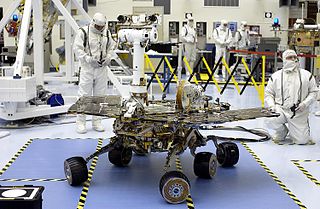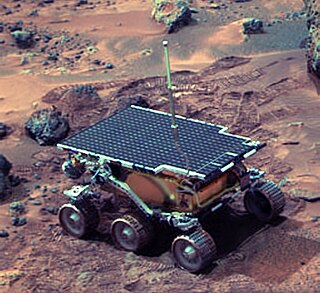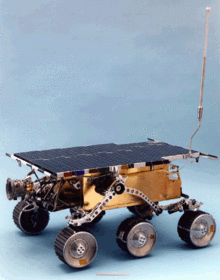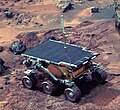
Geoffrey Alan Landis is an American aerospace engineer and author, working for the National Aeronautics and Space Administration (NASA) on planetary exploration, interstellar propulsion, solar power and photovoltaics. He holds nine patents, primarily in the field of improvements to solar cells and photovoltaic devices and has given presentations and commentary on the possibilities for interstellar travel and construction of bases on the Moon, Mars, and Venus.

Mars Pathfinder is an American robotic spacecraft that landed a base station with a roving probe on Mars in 1997. It consisted of a lander, renamed the Carl Sagan Memorial Station, and a lightweight, 10.6 kg (23 lb) wheeled robotic Mars rover named Sojourner, the first rover to operate outside the Earth–Moon system.

NASA's Mars Exploration Rover (MER) mission was a robotic space mission involving two Mars rovers, Spirit and Opportunity, exploring the planet Mars. It began in 2003 with the launch of the two rovers to explore the Martian surface and geology; both landed on Mars at separate locations in January 2004. Both rovers far outlived their planned missions of 90 Martian solar days: MER-A Spirit was active until March 22, 2010, while MER-B Opportunity was active until June 10, 2018.

Spirit, also known as MER-A or MER-2, is a Mars robotic rover, active from 2004 to 2010. Spirit was operational on Mars for 2208 sols or 3.3 Martian years. It was one of two rovers of NASA's Mars Exploration Rover Mission managed by the Jet Propulsion Laboratory (JPL). Spirit landed successfully within the impact crater Gusev on Mars at 04:35 Ground UTC on January 4, 2004, three weeks before its twin, Opportunity (MER-B), which landed on the other side of the planet. Its name was chosen through a NASA-sponsored student essay competition. The rover got stuck in a "sand trap" in late 2009 at an angle that hampered recharging of its batteries; its last communication with Earth was on March 22, 2010.

Opportunity, also known as MER-B or MER-1, is a robotic rover that was active on Mars from 2004 until 2018. Opportunity was operational on Mars for 5111 sols. Launched on July 7, 2003, as part of NASA's Mars Exploration Rover program, it landed in Meridiani Planum on January 25, 2004, three weeks after its twin, Spirit (MER-A), touched down on the other side of the planet. With a planned 90-sol duration of activity, Spirit functioned until it got stuck in 2009 and ceased communications in 2010, while Opportunity was able to stay operational for 5111 sols after landing, maintaining its power and key systems through continual recharging of its batteries using solar power, and hibernating during events such as dust storms to save power. This careful operation allowed Opportunity to operate for 57 times its designed lifespan, exceeding the initial plan by 14 years, 47 days. By June 10, 2018, when it last contacted NASA, the rover had traveled a distance of 45.16 kilometers.

A Mars rover is a remote-controlled motor vehicle designed to travel on the surface of Mars. Rovers have several advantages over stationary landers: they examine more territory, they can be directed to interesting features, they can place themselves in sunny positions to weather winter months, and they can advance the knowledge of how to perform very remote robotic vehicle control. They serve a different purpose than orbital spacecraft like Mars Reconnaissance Orbiter. A more recent development is the Mars helicopter.

The Mars Surveyor 2001 project was a multi-part Mars exploration mission intended as a follow-up to Mars Surveyor '98. After the two probes of the 1998 project, Mars Climate Orbiter and Mars Polar Lander, were both lost, NASA's "better, faster, cheaper" exploration philosophy was re-evaluated, with a particular eye on the two 2001 project probes. As a result, the mission, along with the launch of its lander and rover, were canceled in May 2000, but the decision was made to continue development with its orbiter counterpart. The orbiter launched as 2001 Mars Odyssey in April 2001, in a mission independent of the Mars Surveyor project, and reached Mars in October 2001. After being placed in a cleanroom in 2001 and stored since, the nearly-completed lander component was eventually reused to fly the Phoenix mission, which launched in August 2007 and landed successfully on Mars in May 2008.

Yogi Rock is a rock on Mars that was discovered during the Mars Pathfinder mission in 1997, and named by Geoffrey A. Landis. The rocks found on the mission were named after famous icons and figures, and Yogi Rock was thought to resemble the head of a bear looking away from the spacecraft. As a result, it was named for the famed cartoon character Yogi Bear.

In space exploration, in situ resource utilization (ISRU) is the practice of collection, processing, storing and use of materials found or manufactured on other astronomical objects that replace materials that would otherwise be brought from Earth.

A Mars landing is a landing of a spacecraft on the surface of Mars. Of multiple attempted Mars landings by robotic, uncrewed spacecraft, ten have had successful soft landings. There have also been studies for a possible human mission to Mars, including a landing, but none have been attempted. Soviet Union’s Mars 3, which landed in 1971, was the first successful Mars landing. As of 2023, the Soviet Union, United States and China have conducted Mars landings successfully.
MESUR, the Mars Environmental SURvey was a NASA program designed to explore the planet Mars in preparation for human follow-up missions of the Space Exploration Initiative. The only mission of the program that was completed was MESUR Pathfinder.

Martian soil is the fine regolith found on the surface of Mars. Its properties can differ significantly from those of terrestrial soil, including its toxicity due to the presence of perchlorates. The term Martian soil typically refers to the finer fraction of regolith. So far, no samples have been returned to Earth, the goal of a Mars sample-return mission, but the soil has been studied remotely with the use of Mars rovers and Mars orbiters.

Martian dust devils are convective atmospheric vortices that occur on the surface of Mars. They were discovered from data reported by NASA's Viking probes, and have been photographed by orbiting satellites and surface rovers in subsequent missions.

A cleaning event is a phenomenon whereby dust is removed from solar panels, in the context of exploration and science rovers on Mars, supposedly by the action of wind. The term cleaning event is used on several NASA webpages; generally supposing that Martian winds have blown dust clear off the probes on Mars, including the solar panels which power them, increasing their energy output. The nature of the cleaning events is not known, but the assumption is that wind blows the dust off the panels. Cleaning events were discovered in 2004 when several times power levels increased by 5% overnight, in contrast to the expectation they would decrease—the added power allowed the missions to continue beyond their expected lifetime. One theory is that wind currents in craters aid in cleaning events, and also if the rover is sloped, this is speculated to help remove dust.
Morten Bo Madsen is a Danish physicist, associate professor at the Niels Bohr Institute. He was a co-investigator on the Phoenix Mars mission which proved the presence of water on Mars.

Sojourner is a robotic Mars rover that landed in the Ares Vallis channel in the Chryse Planitia region of the Oxia Palus quadrangle on July 4, 1997. Sojourner was operational on Mars for 92 sols. It was the first wheeled vehicle to rove on a planet other than Earth and formed part of the Mars Pathfinder mission.

A Mars habitat is a hypothetical place where humans could live on Mars. Mars habitats would have to contend with surface conditions that include almost no oxygen in the air, extreme cold, low pressure, and high radiation. Alternatively, the habitat might be placed underground, which helps solve some problems but creates new difficulties.
The following outline is provided as an overview of and topical guide to Mars:

The Mars Environmental Dynamics Analyzer (MEDA) is an instrument on board the Mars 2020 Perseverance rover that will characterize the dust size and morphology, as well as surface weather. Specifically, the information obtained will help address future human exploration objectives, as dust sizes and shapes, daily weather report and information on the radiation and wind patterns on Mars, that are critical for proper design of in situ resource utilization systems. MEDA is a follow-on project from REMS, of the Curiosity rover mission. MEDA has an increased scope, with greater data collection on Mars dust which contributes to overall Mars program objectives and discovery goals.

















